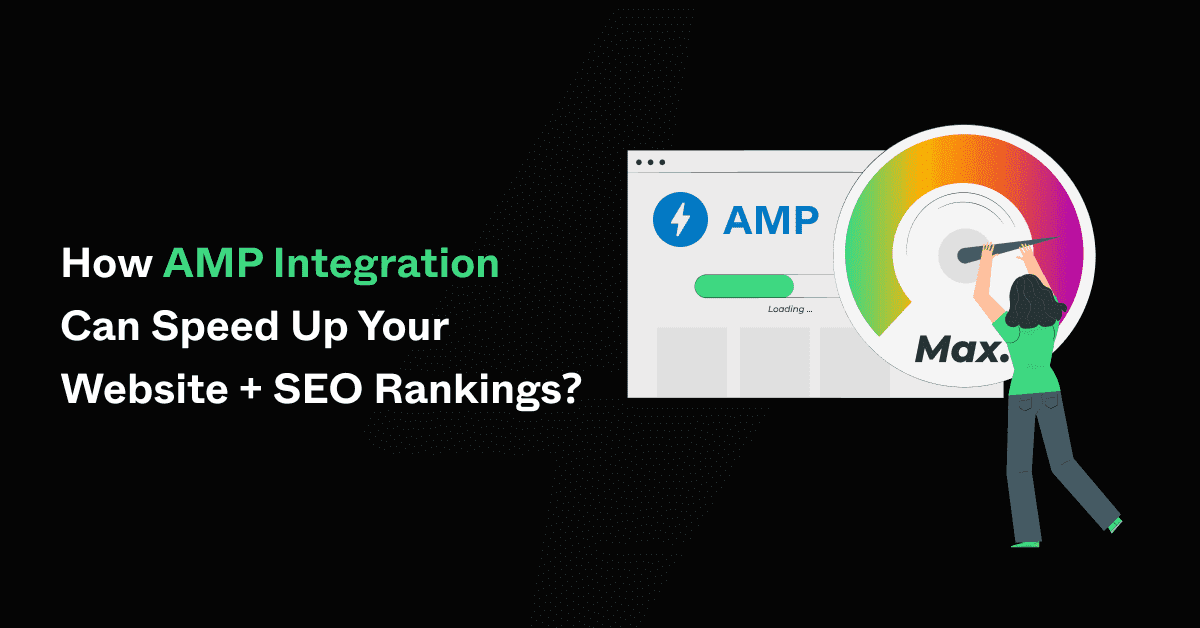Optimizing website speed can offer many benefits to users. When Google took the initiative for the open-source project named “Accelerated Mobile Pages,” – it drew the attention of business owners for a faster mobile experience. In this article we discuss How AMP Integration Can Speed Up Your Website And SEO Rankings.
In an ever-spreading ‘Global Online Network’ – speed and user experience secure the top spot across any platform. When these two elements are combined, the result is more engagement and more visitors, which means more revenue for businesses.
Hence, it was quite apparent that publishers needed an extra topping of some sort that allows the mobile website content to render almost right away. With that in mind, Accelerated Mobile Pages made its way to benefit SEO, especially in two areas, viz., to be quick on SERP, and act as a ranking factor. So, let’s understand what AMP is and how it works.

Table of Contents
What is AMP?
Incepted in 2015, and by 2016, Google AMP’s main motto is to make web content load faster for mobile users. AMP streamlines pages using bare minimum HTML and Javascript, which otherwise takes several seconds to load pages with rich content.
How does AMP work?
We are going to see the three essential parts that AMP consists of, and more in-depth can be found here by columnist Paul Shapiro on how you can mark up your mobile pages for a better mobile user experience.
- AMP HTML: A subset of HTML, this markup language has some custom tags and properties and many restrictions. In any case, on the off chance that you know about standard HTML, you ought not to experience issues adjusting existing pages to AMP HTML. For additional details on how it varies from essential HTML, look at AMP Project’s rundown of required markup that your AMP HTML page “must” have.
- AMP JS: A JavaScript framework for mobile pages. For the most part, it manages resource handling and asynchronous loading. Also, note that AMP does not permit third-party JavaScript.
- AMP CDN: An optional Content Delivery Network, it will take your AMP-enabled pages, cache them, and automatically do some performance optimizations.
But before jumping in with both feet, it is entirely reasonable to know how Google AMP influences SEO and affects your business. Let us understand that with the two most critical elements, i.e., page speed, and mobile user-friendliness.
Impact of AMP on SEO
An improved page loading speed and ease of user interface affect SEO, hence its connection with AMP will also affect SEO performance.
1) Page Speed – AMP can’t imply as an organic search ranking factor. But its increased importance has made it one of the essential elements to increasing efficiency on your web pages. Moreover, since AMP pages use less data they tend to load faster than non-AMP pages, marginally leaving 2.5 seconds of the time difference between them both.
2) Mobile User-friendliness – To bring the most relevant and friendly results back to users Google considers user experience as a critical ranking factor. What appears on the search engine page results (SERPs) is not connected – it can positively influence your web page’s mobile-friendliness and speed. Google AMP does have a substantial effect on the mobile-friendliness of your website.
How to Implement AMP on Your Site?
Here is a quick guide if you wish for AMP to work on your WP site. Follow these steps to integrate AMP quickly.
1) Install the AMP WordPress plugin
2) Activate the plugin. This will append /amp on all your pages but won’t redirect mobile visitors to your /amp pages.
3) Edit .htaccess file – using an FTP program such as Filezilla or any other.
4) The last step is to edit CSS to make your AMP pages look and feel more like your site. You can do this in your WP content–plugins–amp–template.php
If your site is not WordPress and you wish to create your first AMP page, then learn how to integrate (click here) from Moz’s recent Whiteboard Friday video.
Benefits of AMP
When you think of AMP pages, you’ll need to exclude lead forms, on-page comments, and other such standardized elements from your pages. Because it is load-sensitive, you’ll need to streamline all CSS in AMP below 50kb as well as use a particular amp-font extension. AMP also supports slideshows via amp-carousel and image lightboxes via amp-image-lightbox for news sites on a mobile device. Let us see the benefits of AMP:
1) Improve UX – Google AMP helps in improving user experience
2) Enhance Mobile Search Results – Optimized content can be developed and quickly loaded at various places at a given time. Additionally, help your site appear on the carousel featured on the SERP.
3) Incremental Site Exposure – Drastically improving your site’s visibility in terms of traffic.
4) Reduce Load – A substantial reduction is noted in the page load time while improving the chances of a user staying on the website for longer times.
5) Enhanced SEO – Since there is no need to customize your web content, search engines can easily discover your web page.
6) Adjustment on any browser – Customization for their webpages. They can also be molded in any browser type.
7) Optimized Data Consumption – Allows users to install the website as an app on their home screen without taking the user to an app store.
8) No Sitemap Required – If you have created an AMP Pages, there is no need to make a XML sitemap for those URLs google will preference themselves.
To AMP or Not to AMP?
If you are already utilizing maximum resources to improve your site’s mobile loading speed, then implementing AMP might not seem necessary. The following scenario explains wherein AMP isn’t for you:
1) Already using CDN – CDN uses smart file caching rules, structured session routing optimization algorithms, purged unused files and in-built image compression to lower page load time by up to 50%. The content delivery network will make sure to host your image files and other content on your site.
2) Already Compressed Code – AMP increases efficiency by disabling plugins and JS assets. It removes unwanted code elements to make the page quickly viewable. Smaller screen designs will also pave the way to ease the mobile-friendliness of your site.
3) Single CSS reference – The main objective is to bring all your style sheets into one master CSS resource. To begin with, do not place the in-line CSS on every page of the website. Instead, set your site’s code to reference an external CSS file called from your CDN. More often than not, it is the number of queries that weigh down the content loading capacity on your site rather than the size of the files.
Wrap Up
AMP offers versatile benefits to publishers with improved site speed, better user experience, and more revenue only if they take time and implement the AMP version. Moreover, it also helps you with the analysis and tracking issue to get the most relevant and optimum results.
Join The Logo Community
We hope you have enjoyed this article about How AMP Integration Can Speed Up Your Website And SEO Rankings. If you would like more personal tips, advice, insights, and access to our community threads and other goodies join me in our community. You can comment directly on the posts and have a discussion with Andrew, the Founder of The Logo Creative.
*TIP – We recommend Skillshare to learn online. There are tons of classes for everything including graphic design, web design, marketing, branding and business related courses. Get a free 2 months with our link and you won’t regret it Trust us!
Author Bio
Graceful for the life he has got, Maulik Pandya, the founder of Evince Development, finds it fulfilling to be surrounded by either technology or his family and friends. With over 8+ years of experience, he is now exploring new ways to deliver growth & digital solutions to a business that is just starting up or established.



